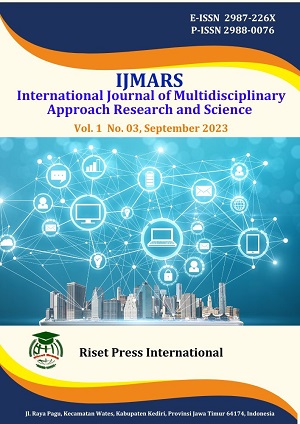Analysis of the Simultaneous Problems of Poverty and Gross Domestic Product (GDP) as Macroeconomic Factors in a Developing Country
DOI:
https://doi.org/10.59653/ijmars.v1i03.228Keywords:
Poverty, GDP, simultaneous equation model, 2SLS, macroeconomicsAbstract
When analysing macroeconomic factors using an econometric approach that attempts to determine the successful economic development of countries, such as in the analysis of poverty and gross domestic product (GDP), problems have been repeatedly encountered in considering the variables involved simultaneously. To overcome this problem, it is necessary to use the two-stage least squares (2SLS) method as the best estimator by applying the simultaneous equation model. The objective of this study is to analyse the simultaneous equation model between poverty and GDP in a developing country such as Indonesia. The macroeconomic data sources used for this study are secondary time series data from 1990 to 2017 obtained from Indonesia Statistics Agency, IMF, UNDP and World Bank. The result shows that there is strong evidence that poverty and GDP act simultaneously or endogenously in the model. From the results, it is recommended that in order to achieve higher GDP in the future, the Indonesian government should pay more attention to alleviating poverty rates, reducing unemployment rates, lowering merchandise imports, and improving economic growth in addressing macroeconomic problems in the country.
Downloads
References
Ames, B., Brown, W., Devarajan, S., & Izquierdo, A. (2001). Macroeconomic policy and poverty reduction (Issues 12–296). International Monetary Fund.
Aye, G. C. (2013). Causality between financial deepening, economic growth and poverty in Nigeria. The Business & Management Review, 3(3), 1.
Berenson, M. L., Levine, D. M., Szabat, K. A., & Stephan, D. F. (2019). Basic business statistics: Concepts and applications. Pearson.
Cowen, T., Tabarrok, A., & Tabarrok, A. (2021). Modern principles: microeconomics. Worth Publishers New York.
Greene, W. H. (2018). Econometric analysis (Eight Edition). Pearson.
Greenlaw, S. A., Shapiro, D., Richardson, C., Sonenshine, R., Keenan, D., MacDonald, D., Dodge, E., Gamez, C., Jauregui, A., & Moledina, A. (2017). Principles of Micro-economics 2e. for AP® Courses. Rice University.
Gujarati, D. (2004). Basic Econometrics.(4 th edtn) The McGraw− Hill Companies. Search In.
Gujarati, Damodar. (2014). Econometrics by example. Bloomsbury Publishing.
Hassler, U. (2016). MH Pesaran (2015): Time series and panel data econometrics. Oxford University Press, Oxford, 1104 pp, Hardcover 110.00£, ISBN: 9780198736912. Springer.
Janvry, A. de, & Sadoulet, E. (2000). Growth, poverty, and inequality in Latin America: A causal analysis, 1970–94. Review of Income and Wealth, 46(3), 267–287.
Jonnadi, A., Amar, S., & Aimon, H. (2012). Analisis pertumbuhan ekonomi dan kemiskinan di indonesia. Jurnal Kajian Ekonomi, 1(1).
Kõrösi, G. (2016). A lány továbbra is szolgál.../MODELLING AND ECONOMETRICS. Közgazdasági Szemle, 63(6), 647.
Qasim Alabed, Q. M., Said, F. F., Abdul Karim, Z., Shah Zaidi, M. A., & Alshammary, M. D. (2021). Energy–Growth Nexus in the MENA Region: A Dynamic Panel Threshold Estimation. Sustainability, 13(22), 12444.
Sloman, J., & Garratt, D. (2010). Essentials of economics. Pearson Education.
Stock, J. H., & Watson, M. W. (2003). Introduction to econometrics (Vol. 104). Addison Wesley Boston.
Wooldridge, J. M. (2015). Introductory econometrics: A modern approach. Cengage learning.
Downloads
Published
How to Cite
Issue
Section
Categories
License
Copyright (c) 2023 Muhammad Masyhuri

This work is licensed under a Creative Commons Attribution-ShareAlike 4.0 International License.
Authors who publish with this journal agree to the following terms:
- Authors retain copyright and grant the journal right of first publication with the work simultaneously licensed under a Creative Commons Attribution-ShareAlike that allows others to share the work with an acknowledgement of the work's authorship and initial publication in this journal.
- Authors are able to enter into separate, additional contractual arrangements for the non-exclusive distribution of the journal's published version of the work (e.g., post it to an institutional repository or publish it in a book), with an acknowledgement of its initial publication in this journal.
- Authors are permitted and encouraged to post their work online (e.g., in institutional repositories or on their website) prior to and during the submission process, as it can lead to productive exchanges, as well as earlier and greater citation of published work (See The Effect of Open Access).
























